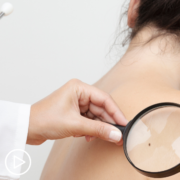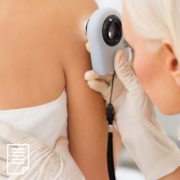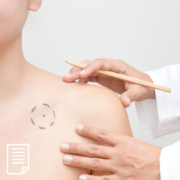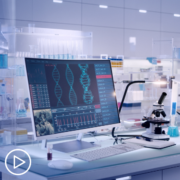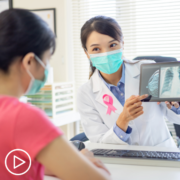Advanced Non-Melanoma Skin Cancer Treatment Decisions: What’s Right for You?
Advanced Non-Melanoma Skin Cancer Treatment Decisions: What’s Right for You? from Patient Empowerment Network on Vimeo.
When considering an advanced non-melanoma skin cancer treatment approach, what helps determine the best treatment for YOU? Dr. Vernon Sondak discusses key treatment decision factors, emerging research, and shares tips for collaborating with your healthcare team.
Katherine:
Hello and welcome. I’m Katherine Banwell, your host for today’s webinar. In this program we’re going to help you learn more about advanced non-melanoma skin cancer, what it is, and how it’s treated. And we’ll share tools to help you work with your health care team, to access the best care.
Before we meet our guest, let’s review a few important details. The reminder email you received about this program contains a link to program materials. If you haven’t already, click that link to access information to follow along during this webinar. At the end of this program, you’ll receive a link to a program survey. Please take a moment to provide feedback about your experience today, in order to help us plan future webinars.
And finally, before we get into the discussion, please remember that this program is not a substitute for seeking medical advice. Please refer to your health care team about what might be best for you.
Joining us today is Dr. Vernon Sondak. Dr. Sondak, welcome. Would you please introduce yourself?
Dr. Sondak:
Thank you and I’m glad to be here. I’m Vern Sondak. I’m the chair of the Department of Cutaneous Oncology at Moffitt Cancer Center in Tampa, Florida. Cutaneous oncology is, of course, the diagnosis and treatment of all forms of cancer that start on the skin. I am a cancer surgeon by training, but pretty much do only skin cancers, melanoma, and all the other types of skin cancer that we’re going to be talking about today.
Katherine:
Excellent. Thank you for taking the time out of your busy schedule to join us. Before we learn more about advanced non-melanoma skin cancer, let’s start with the question that’s on the minds of many patients. Is the COVID vaccine safe and effective for advanced non-melanoma skin cancer patients?
Dr. Sondak:
I’ve spent my entire career studying the human immune system and vaccines for cancer. The COVID vaccine is the safest, most effective vaccine we have ever seen. It is like the difference between the Wright brothers airplane and the Apollo spaceships in terms of sophistication.
It is a vaccine that has gotten politicized and has gotten tangled up in all kinds of stuff. But again, it is the safest, most effective vaccine we’ve ever seen. I highly recommend it for all of our patients. I believe that all of our patients with cancer, and their family members, and their children of appropriate age should be vaccinated and boosted.
Even if you do that, as I have done, I go vaccinated, I got boosted, and I got COVID. It was milder than the usual cold I get every year before COVID. If I hadn’t been tested, I wouldn’t have even known I had it. I only get tested to avoid spreading it to family members and especially to vulnerable patients. If your immune system is weakened and it’s even more important to be vaccinated.
So, the only advice I give to my patients about the vaccine, and the vaccination specifically, is think about which arm to have it in. If you’ve got an active cancer, say in the left arm, have it in the right arm. Not because it will hurt the cancer, but because in the early days after the vaccine, you may get a little bit of swelling of the lymph nodes. We don’t want your doctor or anybody doing a CAT scan, or ultrasound, or mammogram, or any other test to accidentally think that those enlarged lymph nodes are from the cancer.
If you had the vaccine recently and are getting any type of diagnostic procedure, like a CAT scan mammogram or ultrasound of those lymph nodes, tell the team that you had a recent COVID vaccine.
Katherine:
That’s excellent advice. Thank you. Good to know. Let’s start with the basics Dr. Sondak. What exactly is non-melanoma skin cancer?
Dr. Sondak:
Well, it’s a great question. Sometimes we wish there was a better term, because it obviously is defining this by what it’s not, not by what it is.
Katherine:
Right.
Dr. Sondak:
Melanoma is the most prevalent of the really severe skin cancers. By severe, I mean the ones with the highest chance of spreading and dying. Each year in the United States, there are close to 10,000 deaths from melanoma every year, and about 100,000 cases of invasive melanoma.
But the other forms of skin cancer, and the most common two forms of skin cancer, are basal cell and squamous cell cancers. These two cancers alone, they are about two to three million cases a year, compared to 100,000 melanoma cases.
Katherine:
Wow.
Dr. Sondak:
But probably causing fewer deaths than those 100,000 melanomas. So, there are many, many more of the skin cancers that aren’t melanoma, then there are of the skin cancers that are melanoma.
In fact, there are probably more skin cancers – just if we took basal and squamous cell cancer – there are probably more of those diagnosed every year in the United States than all other forms of cancer put together.
Katherine:
Wow. Wow.
Dr. Sondak:
Now in general, these skin cancers – besides melanoma – are at a low risk of spreading, and metastasizing, and killing the person if their immune system is normal. So, they have almost gotten passed off as, “Oh, it’s just the skin cancer. It’s nothing to worry about.” But when they reach a certain size, when they get to a point where we call them advanced, then now the stakes are higher. It’s not millions of advanced cases, but it’s many tens of thousands of advanced cases in the United States. Some of them do spread and some of them can be life threatening, or even lethal.
Katherine:
And we are going to focus today on advanced disease. So, what makes this type of cancer considered advanced?
Dr. Sondak:
So, this also is somewhat – I won’t say controversial. I’ll just say it’s not uniformly agreed on by everybody. Not everyone means the exact same thing or has the exact same definition in their mind when they say advanced.
It’s a little different than the stage. The staging of skin cancer is mostly based on the size. So, a small skin cancer is almost never an advanced skin cancer. By small I mean less than 2 centimeters, sometimes. Depending where. Two centimeters is just under an inch.
But 2 centimeters in the middle of your face or on the tip of your nose. That’s already a pretty big problem. So, somebody might say, “Well, that’s kind of advanced.” Yes it is. But that’s not what we’re really talking about here. We’re talking about larger tumors. Tumors that have spread deeply into the tissues, or tumors that have spread and gotten to the next stages. Stage III, meaning in the lymph nodes. Or stage IV, meaning it’s spread beyond the lymph nodes, to the lungs and beyond.
In terms of stages, in terms of stage III and stage IV, basal and squamous cell cancers, we are talking about much fewer than 2 percent of all those skin cancers. For basal cell, way fewer. For squamous cell, slightly fewer than 2 percent of all cases ever getting to a higher stage, like stage III and stage IV.
Sometimes they can be very advanced without ever spreading to the lymph nodes or beyond because they invade down into the bone. Could be on the top your scalp and invade down into your skull bone. Can be on the cheek, and invade, and follow the track along the nerves of the face. A lot of ways that the skin cancer can become advanced without spreading. But cancers that have spread are automatically considered advanced.
Katherine:
Right. That helps us understand the disease and how it progresses.
There are so many factors that come into play when making a treatment decision, including a patient’s age and overall health. So, let’s walk through the considerations when choosing therapy for advanced disease. What are the treatment goals? What does that mean and what are the goals?
Dr. Sondak:
It’s actually really important and somewhat underrated to think about, “What’s the goal of the treatment?” I think even doctors sometimes, certainly medical students and trainees, it’s something they have to learn a lot about. Because it’s easy to memorize all the names of all the drugs and all the muscles in the body. But thinking about, “What are we really trying to accomplish here?”
The first thing we would like to accomplish, when we can, is cure the cancer. Most of the advanced skin cancers we’re talking about are still curable. We can’t say all, but most. Even in the high stages they are still potentially curable with treatment.
So, of course, if we can cure someone, we might be more aggressive with our treatment plan. More intensive with our treatment than if we’re not intending to cure them. Why wouldn’t we want to cure them? Why would we have a different intention? We’d always want to, but there are times when we say, “Gee, the standard treatments haven’t worked. Now we have to think about what other goals? We can’t cure you anymore.”
It’s pretty rare with skin cancer. But it happens. It happens with melanoma, and it happens with basal, and squamous cell cancers, but rarely.
We can’t cure you. We can help you feel better because the symptoms that this large skin cancer – this advanced skin cancer – is causing. Whether they might be bleeding, or pain, or pressure on a nerve, or whatever it might be. If we can relieve that, that’s palliation. That’s relieving symptoms. There are times we say, “We want to prevent that symptom from happening in the first place. If we don’t remove this, this is going to start bleeding, or it’s going to press on the nerves.”
So, even if we can’t cure you, we might want to treat one or more spots to prevent symptoms from occurring. Only in the most extreme, end of the line, kind of situations would we say now our goal is just comfort. We can no longer do anything to really alter the disease. When and how we make those decisions, obviously, they are challenging. But if you don’t start with that point, then you can’t get to the right treatment decision.
If you’ve got a patient who’s not curable, you want to do the least treatment to make them feel better or prevent them from feeling bad. Whereas if you’ve got a patient who is curable, you may be willing to justify much more aggressive treatment, if that’s what’s needed to cure them.
Katherine:
How do patient-specific factors, like lifestyle and pre-existing conditions, impact treatment choices?
Dr. Sondak:
It really depends, but in skin cancer it can affect them a lot.
Number one: Lifestyle. Well, how did we get skin cancers in the first place? Whether they’re melanoma, basal, squamous? Usually, the one common denominator is ultraviolet light. Got it from being out in the sun or occasionally from being in a tanning bed. Something like that. Melanomas, and to a small extent basal cell cancers, tend to be associated with brief intermittent heavy exposure, meaning sunburns. Squamous cell cancer tends to be associated with chronic cumulative years of sun exposure. I was out in the sun all my life, I fished all the time, I was a lifeguard, what have you. That’s generalization.
A lot of overlap. But the common denominator, the common theme, is ultraviolet exposure. One thing about the sun, it doesn’t just shine on one spot all the time. It shines on lots of places. So, you may have a skin cancer here, but that doesn’t mean you didn’t get sun exposure there, or here, or anywhere else.
So, lifestyle factors. One: We can’t undo the ultraviolet exposure you already had. But we can prevent it from accumulating further. So, once a person is diagnosed with skin cancer, they really need to think about protecting themselves from the sun, avoiding sun exposure, and covering their skin, and protecting their skin when they’re in the sun. Ideally, they think about it before they got skin cancer. So, they don’t get skin cancer. Or if they get it, they get a mild, minimal, non-advanced, and easily treatable case.
But we want to make sure that once a person has skin cancer, that they recognize that their lifestyle needs to change. Cigarette smoking, unbeknownst to a lot of people, is also associated to some degree with skin cancers and a lot of other big and bad medical problems. So, we would love to alter people’s lifestyle as far as smoking is concerned. Those are the couple of key lifestyle factors that we always think about.
I think the other area that is so important in deciding about treatment is the overall health of the patient, other medical conditions that they might have, and then lastly, what the patient’s own specific concerns and considerations are.
Katherine:
Yeah. Let’s turn now to the treatment options for advanced disease. What approaches are currently available to treat advanced non-melanoma skin cancer?
Dr. Sondak:
First and foremost, we always think about, can this thing be entirely removed? Can we get the cancer out and cure the patient once and for all with an operation?
Most skin cancers have not yet spread to the lymph nodes or beyond, even when they’re advanced. So, it follows that if we can remove every last cancer cell from that site, we can cure that patient. That is obviously a worthwhile goal.
But these skin cancers occur in places where a big enough surgery to remove all the cancer can be a pretty deforming surgery. It’s why plastic surgeons get involved a lot. But it’s also why we try combinations of therapy to see if we can get by with less surgery, less radical surgery. Perhaps by adding radiation or adding drug treatments to shrink the cancer.
So, surgery first. Can we do it? Can we just fix this once and for all with surgery and get it done? Whether it’s Mohs, for more advanced cases, usually a general anesthesia type surgery. Often with a skin graft or other kind of plastic surgery reconstruction. Could we just get it all out and have the pathologist tell us, “This is done. This is taken care of”? It’s not a guarantee. There’s no guarantees in this business. Only in the muffler business.
But the odds are good if the pathologist tells us the margins are completely negative. If the pathologist tells us the margins are close here, or positive there, and we don’t think removal of additional tissue is wise, then we may call in the radiation oncologist and say, “Let’s give radiation.” Kill that area where there was a positive margin and give us a margin of safety around the surgery.
In the minority of cases, we say, “This is too big to even tackle with surgery – at least at first – or too widespread. So, we’re going to use drug treatments. If it shrinks, we may use radiation for surgery later. But first, drugs and let’s see what happens after that.”
So, today we have really three main categories of drug therapy. In the old days we had – and it wasn’t that long ago – we had really one category. I’d say that’s only been in the last – not even – 10 years that we’ve had multiple options. But let’s go back 10 years.
Chemotherapy. Standard chemotherapy that people think about with cancer. Hair falls out, nausea as a prominent side effect, suppressing of your immune system, suppressing of your blood counts. That form of chemotherapy was really the only drug therapy we had for advanced melanoma. I mean, advanced non-melanoma skin cancer. Advanced melanoma too could years or more ago.
Now, through progress with melanoma, we have drugs that work in the other kinds of skin cancer. Immunotherapy took the world by storm. It worked so well for melanoma that we tried it in squamous, and merkel cell, and even basal cell cancers, and also saw great results. Now immune therapy is approved in all three of those types of non-melanoma skin cancer.
But there are problems with immune therapy if you have an altered immune system. Especially if you have a kidney transplant, or liver transplant, heart transplant, and we boost your immune system, we run a serious risk of rejection. It isn’t a guarantee, and it can sometimes be managed with additional medications. But it’s something that we have to be very, very, very cautious about, is using immune therapy in someone with a transplant.
So, targeted therapy works when we have a genetic abnormality in a cancer, that we know is only in the cancer, and that we have a drug that can block. For melanoma, if it has a BRAF mutation, we have targeted therapy drugs that target the BRAF mutation.
But non-melanoma skin cancers don’t have BRAF mutations. Squamous cell cancers don’t have mutations that today we can target. Only basal cell cancer, along with melanoma, has a mutation that we can target.
But unlike melanoma – where only some melanomas have the gene mutation in BRAF – basal cells, all the cancers have a mutation in the hedgehog pathway. You can’t pretty much have a basal cell cancer without having a mutation in the hedgehog pathway. Fortunately, we have pills that inhibit that pathway that we call hedgehog inhibitors. Vismodegib, sonidegib, and these drugs are very effective at shrinking even gigantic basal cell cancers.
But the problem with targeted therapy in general, compared to immune therapy, is that the responses don’t tend to last as long. The tumor will shrink very rapidly. But some of those cancer cells figure out a way to mutate further and avoid the drugs that we were using to treat them, and eventually grow back.
Dr. Sondak:
Let me just correct one thing I said about targeted therapy, so I don’t leave the wrong impression. I said there’s not really mutations in squamous cell cancer that can be targeted. There is one called the EGF receptor, or EGFR, that we sometimes target with a drug called cetuximab.
It’s not used as much now with immunotherapy. But it turns out there is some targeted therapy, even for squamous cell cancers. But for basal cell, is where the hedgehog inhibitors are used much more effectively than targeted therapy in most other forms of skin cancer.
Katherine:
Dr. Sondak, do you think a patient should consider a second opinion or consulting a specialist? If so, what would you say to them, to make them feel comfortable to do that?
Dr. Sondak:
So, I would remind everyone – as we said earlier – advanced skin cancer is not something you can pass off. “Oh, it’s just skin cancer. Everybody gets skin cancer. It’s just minor. Just put a band aid on it.” I’ve seen people who’ve neglected these cancers for a long time, thinking they weren’t serious, or thinking that the treatments were going to be too awful, too disfiguring, or too toxic. That’s just not the case anymore.
Everyone with advanced skin cancers should have cutting edge appropriate treatment. Cutting edge doesn’t always mean brand new. It might mean the same surgery we’ve been doing for many years. Just done properly and appropriately for that patient.
So, this is a kind of cancer that usually should be treated by very experienced teams. Especially when drug treatment is needed, often when radiation is needed, and certainly when major surgery is needed. Not just the use of the drugs, but the sequence. Which drug first? Which drug second? When is surgery appropriate? When do we do the radiation?
These are sophisticated decisions, and every patient is different. So, we strongly encourage people to go to a center that has a whole panel of different specialists. And they work and talk to each other. They work with each other, work together, talk to each other, and come up with a plan for each patient. If you just go to one doctor, sometimes – an old saying – when all you have is a hammer, everything looks like a nail. There are times when somebody says, “Well, I can do radiation.” Surgeon says, “I can do surgery.” Oncologist says, “I can do chemo, or targeted therapy, or immunotherapy.”
We want them all together, saying “Yeah, but what should we do for this patient?” That’s the goal that we’re striving for. That’s when you’re going to be the most likely to get the most successful outcome.
Katherine:
Dr. Sondak, what would you like to leave patients with? Are you hopeful?
Dr. Sondak:
We have seen the most dramatic progress in the treatment of these forms of cancer of the skin – melanoma, merkel cell cancer. basal and squamous cell cancers – in my lifetime. Progress I never ever thought I would see. We are not curing everybody, but we are curing a lot more people than we used to.
Yet I still see things about these forms of cancer on the internet that say, “Oh, this is really aggressive. This needs to be treated right away. Don’t wait. Don’t make me go get a second opinion. Have somebody deal with it.”
No. Time out. First thing, it’s better to do it right than to do it right away. Second thing, you don’t get a second chance to make a first impression, and if you go down the wrong treatment path, sometimes you can’t undo that. There is always time to stop and ask, “Am I doing the right thing? Is there somebody who really specializes in this that I should be seeing?”
But the most important advice at all, of course, is you’ve got to get the diagnosis made in the first place. So, that means you have to be willing to go to the doctor, to the dermatologist, to say, “Hey, this doesn’t seem right. It’s just not healing. It just keeps getting worse. What’s going on?”, and then have to be willing to follow up and go through treatments.
If you do, we are extremely optimistic. We are seeing progress, responses, cures that we never thought possible. So, there’s a lot of reason to be optimistic. It’s not always easy. There are plenty of side effects of all the treatments that we talked about. Including surgery, radiation, and all the drugs. But it’s not like it was even 10 years ago. Huge progress for people at any age. So, really, we really are optimistic.
Katherine:
Thank you so much for joining us today. It’s been a pleasure talking to you.
Dr. Sondak:
Thank you for having me. Good luck with all your efforts.
Katherine:
Thank you and thank you to all of our partners. If you would like to watch this program again, there will be a replay available soon. You’ll receive an email when it’s ready. Don’t forget to take the survey immediately following this webinar. It will help us as we plan future programs.
To learn more about advanced non-melanoma skin cancer, and to access tools to help you become a proactive patient, visit powerfulpatients.org. I’m Katherine Banwell. Thanks for being with us today.

